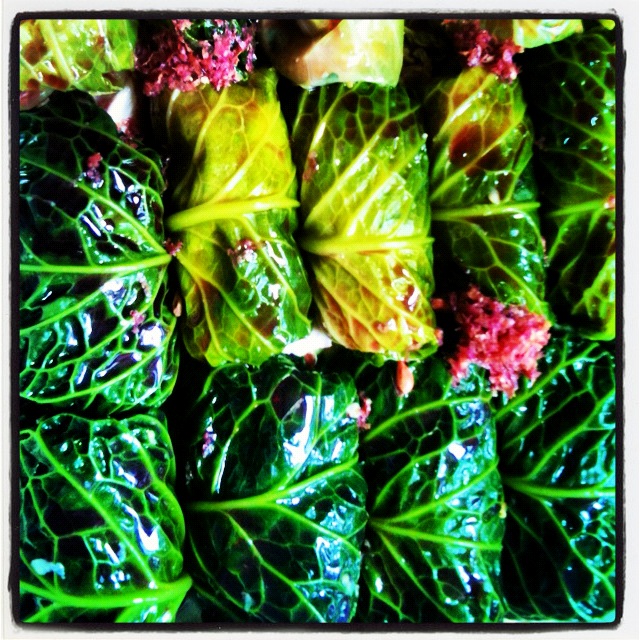Another one of my twisted classics, this beet and black rice risotto will deliver the same satisfying, creamy comfort of a traditional risotto with some major health upgrades. Believe me, my genetics (and last name) make me a ‘rizzotto’ expert.
Let me drop some knowledge on you. Beets are packed with vitamins A, B (1, 2 and 6) and C–take that common cold! They also contain phytonutrients, naturally occurring chemical compounds with demonstrated antioxidant, anti-inflammatory and detoxification properties. Stemming from this burgundy root vegetable (pun intended) are its greens, which boast a higher concentration of iron than spinach. They are also an excellent source of calcium, magnesium, copper, phosphorus and sodium. Not to be neglected are the mighty nutritional characteristics of black rice (which actually turns purple when cooked). By eating 10 spoonfuls of cooked black rice, you are ingesting as many anthocyanins (a potent antioxidant) as one spoonful of the well-known superfood, blueberries.
Now that you know how good the two main ingredients are for you, let me tell you how to make it! Bonus: this can be made vegan simply by omitting the optional goat’s milk gouda.
 What you’ll need:
What you’ll need:
- 1 cup black rice (I use Forbidden Rice)
- 1 quart vegetable stock
- 1 bunch beet greens, stemmed and washed
- 2 tbs extra virgin olive oil
- 1 large yellow onion, coarsely chopped
- 2/3 cup arborio rice
- 4 garlic cloves, minced
- 3/4 cup dry white wine
- 3 large beets (~1 lb) roasted, skinned and diced (Note: advance prep time needed!)
- Salt & pepper
- 2 tbs finely chopped Italian basil
- OPTIONAL:1/2 cup goat’s milk Gouda cheese, grated
How to make it:*
- Before tackling steps 3-8, wrap your beets in foil and roast in an oven pre-heated to 350°F for 45 min-1 hour. When you can stick a fork in and pull it out with ease, they’re done. Immediately remove them from the foil and dunk them in cold water. Use a spoon to pull the skin away, dice them up and set aside.
- Additionally, you’ll need to pre-cook the black rice. To do so combine with 2 cups water in a saucepan, add salt to taste and bring to a boil. Reduce the heat, cover and simmer 30 to 40 minutes, until all of the liquid has been absorbed by the rice. Remove from the heat and let sit for 10-15 min.
- Now, onto the main attraction. Bring vegetable stock to a simmer in a saucepan. Season with salt & pepper and reduce heat to low.
- Take your washed beet greens (you could also use swiss chard), stack them up and cut crosswise into 1/2 inch strips. Set aside.
- In a large saucepan–I use my Le Creuset 5 qt. dutch oven–heat the oil over medium heat and add the onion. Cook until the onion begins to soften (~3 min) and add the arborio rice and garlic. Cook until the grains of rice begin to crackle (~3 min).
- Here comes the labor of love part. Add in the wine and cook over medium heat, stirring constantly. When the wine has almost evaporated, stir in a ladle of the simmering stock (enough to just cover the rice). Cook, stirring continuously, until it is just about absorbed. Add another ladle of the stock and continue adding and stirring like this when the rice is almost dry for 10-15 min.
- Add in the greens, the diced beets and black rice and continue adding more stock, stirring often, for another 10 minutes. If all goes as it’s supposed to you’ll know because the arborio rice will be chewy but not hard in the middle–not soft like steamed rice. If it is still hard in the middle, continue adding stock and stirring for another 5 minutes or so. Add salt to taste.
- When the rice is properly cooked, add a generous amount of pepper, stir in another 1/2 cup of stock, the goat Gouda (again, optional) and the basil. Remove from heat. If the risotto isn’t creamy, add a little more stock, stir for another 5 min and serve.
*Disclaimer: this, like all risottos, is a labor of love. Definitely allocate at least an hour to make this from start to finish–and that doesn’t include the prep step of roasting the beets.
Adapted from Martha Rose Shulman’s “Black Rice and Arborio Risotto With Beets and Beet Greens” featured in NYT on Sept. 4, 2012.





